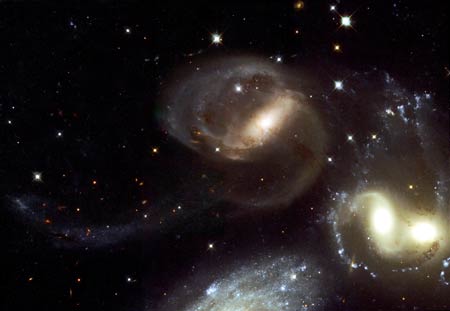
Much of our understanding of the physics of AGN depends on knowing their absolute properties (luminosities, size scales) and thus their distances. There is a small but vocal school which claims that much of the redshift of QSOs (at least) arises not in the Hubble flow but in exotic physical processes, and thus that redshift distances to (some?) QSOs are nonsense. This point of view has been defended in Arp's book (Quasars, Redshifts, and Controversies, Interstellar Media, Berkeley, lately joined by Seeing Red: Redshifts, Cosmology and Academic Science), with some of his best cases.
The observational suspicion that some AGN might be at noncosmological distances seems to have first arisen when Arp (1967 ApJ 146, 321) noted an association between several low-redshift peculiar galaxies and quasars in a rough pairing sense, with pairs of QSOs on each side of the galaxy. Specific two-color searches led to identification of numerous QSOs in te fields of nearby galaxies (see, for example, Arp 1981 ApJ 250, 31 and references therein).
There has been much fruitless discussion of what might appear a straightforward statistical problem - are there or are there not excess QSOs in the directions of bright galaxies? The difficulties lie in the fact that QSO searches are still quite inhomogeneous over the sky, and thus a search may be deep enough to tell us something but cover too little solid angle, or cover the whole sky with too few QSOs. For example, there are four close galaxy-QSO pairs in the 3C catalog (Burbidge, Burbidge, Solomon, and Strittmatter 1971 ApJ 170, 233). These are pretty famous pairs now - namely NGC 3067/3C 232, NGC 4651/3C 275.1, NGC 4138/3C 268.4, and NGC 5832/3C 309.1. But with only about 100 quasars over half the sky, the statistics were too sparse to do more. Perhaps large-scale automated surveys will be able to resolve this (using not only multicolor optical selection, but identifications of ROSAT survey sources). The methodology Arp has frequently adopted doesn't help - starting from a galaxy and searching outward until a quasar shows up, then if it's "interestingly" close keep on going outward. This is guaranteed to produce an apparent excess, on the "seek and ye shall find" principle. A final problem with a statistical analysis is that it is not always clear what it is whose likelihood we want to assess. Some papers talk about QSO-galaxy pairs, some about QSO pairs with discordant redshift, lines of quasars... Statistics after the fact has a bad reputation. As if to make things worse, we do expect an excess number of quasars in the directions of galaxies at some redshift ranges from gravitational lensing, as long as the QSO counts rise rapidly with magnitude, even ina boringly conventional picture.
If any of these claims hold up, extragalactic astronomy is in for a real shock. We will examine the direct issues individually, hoping to avoid the "oh yes it is - oh no it's not" tone of many published papers.
Association of galaxies at disparate redshifts. There are some amazing cases of objects with wildly different redshifts but showing the appearance of direct interaction. No two seem to be of the same kind, and there are more or less plausible ad hoc conventional interpretations depending on how much of a statistical fluke one is willing to believe out of a given number of galaxies. Some of the most notorious cases are Stephan's Quintet, NGC 4319/Mkn 205, and NGC 7603.
Stephan's Quintet is a compact group (probably the first to be found) in which four of the members have redshifts cz = 5700 - 6700 km/s, while the remaining member NGC 7320 has redshift only 800 km/s, close to that of the bright spiral NGC 7331 only abour 1/2° away. NGC 7320 is of larger angular size than the other members, but only less than a factor 2. NGC 7320 shows a low-surface-brightness tail approximately opposite the other group members. Detection of even fainter structure is thwarted by especially strong galactic "cirrus" reflection in this area. Sizes of H II regions have been used to argue for various distances, but as Kennicutt has shown, linear sizes are unreliable distance indicators. The distribution of H II regions has been considered (Arp 1966 ApJ) as evidence for interaction with the other members, but Hodge showed in a later set of papers that the brightest H II regions in pairs do not necessarily occur between the galaxies in question. Supernovae and velocity dispersions are consistent with the redshift distances for the higher-redshift members. A crucial test would be direct resolution into stars, unless one is willing to invoke some magical mechanism by which the stars are all made faint in galaxies of anomalous systems so that the galaxies will be completely indistinguishable from much more distant ones. This has probably been resolved (literally) by HST imaging, such as the WFPC2 mosaic released by ESA and reproduced below, in which the magnitudes of brightest stars are clearly quite different in NGC 7320 and the other members.

Markarian 205 was reported by Weedman as a Seyfert nucleus appearing within the arms of the lower-redshift spiral galaxy NGC 4319. Most of the argument here has centered on whether or not there is a visible connection between the two. Pictures were published with and without a bridge (Arp once said that he had pictures that showed no bridge as well, and didn't want to be thought lacking in observational skill). There was some early discussion of photographic proximity effects creating false bridges between bright objects, but it doesn't go away with linear detectors. Various reports were given by Arp 1971 (ApLett 9,1), Lynds and Millikan 1972 (ApJLett 176, L5), Stockton et al 1979 (ApJ 231, 673), and Sulentic 1983 (ApJLett 265, L49). Cecil and Stockton (1985 ApJ 288, 201) used CCD data from Mauna Kea to show that there is definitely some kind of luminous object between Mkn 205 and NGC 4319, stating that "Arp was correct in his insistence that his broad-band plates showed luminous intervening material. The opposite conclusions of his critics were - depending on their degree of qualification - either wrong, misleading, or irrelevant." They go on to say that Mkn 205 itself has a companion 3.3 arcseconds away, and that a tidal feature attributable to this interaction probably accounts for much of the luminous connection. More problematic is the evidence that this connection winds its way all the way into the nucleus of NGC 4319 (Sulentic 1983). Furthermore, it belongs to the very select set of galaxies with peculiar, nonstellar ionization of gas throughout the disk (Sulentic and Arp 1987 ApJ 319, 693). I must point out that NGC 4319 has a bright elliptical companion which is usually outside the area of published pictures and might be responsible for some of its morphological woes. This system is well shown (though nothing much new shows up relevant to the redshift issue) in the Hubble Heritage image, shown below as is and with a brightness stretch to bring out the intervening material.
 |
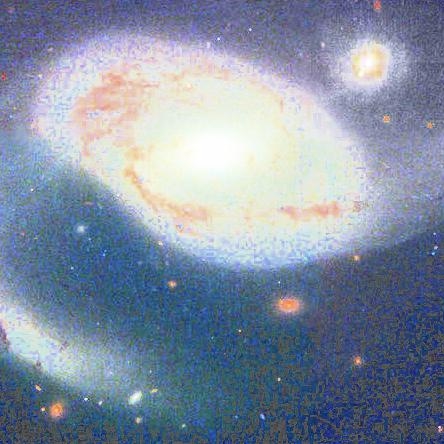 |
NGC 7603 is a Seyfert galaxy with disturbed form and an apparent companion along an extended arm or tail. NGC 7603 has a redshift of 8700 km/s and the companion is at 17,000 km/s. Sharp (1986 ApJ 302, 245) shows deep stacked images revealing more extensive structure around NGC 7603, and showing that the velocity dispersion of the companion gives ambiguous results as to its distance (right in the middle with large error bars). Unlike some of the other cases, the high-redshift galaxy has quite normal spectroscopic properties.
There are additional cases sometime discussed; see the list on p. 86 of Arp's book. One may also add a discrepant-redshift galaxy in the chain or compact group VV172.
Quasar-Galaxy Statistics. This is the crux of the debate on quasar redshifts. First, is there compelling evidence of quasars occurring in the direction of nearby galaxies? And second, can such an excess be explained by something like gravitational microlensing?
Arp conducted numerous searches using U-B colors for quasars near bright galaxies, and concluded that certain kinds of companion galaxies were especially likely to have associated QSOs. The radial distribution of these objects is not too different from that of a spheroid (de Vaucouleurs profile), as shown by Keel 1982 (ApJLett 259, L1) in checking for evidence of lensing:
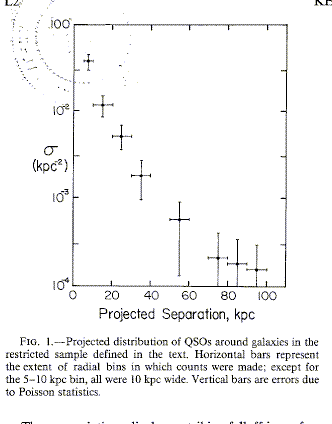
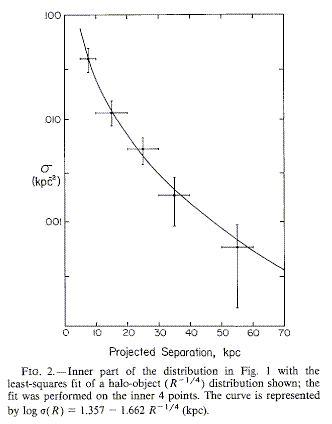
However, some of this is an artifact of Arp's center-outward search procedure. Real progress here will require large, objectively selected QSO samples covering significant solid angle. Also, the ststistical analysis for associations has often been clouded by uncertainies as to what one is testing for. We need to know not just the probability of seeing what we do, but of seeing something "sufficiently interesting", be that pairs, lines, associations in angle, or whatever. Various papers dispute probabilities by factors of 107.
There are clearly some very striking single objects, such as the three quasars seen along the line of sight to NGC 1073 (Arp and Sulentic 1979 ApJ 229, 496) and another three near NGC 3842 (Arp and Gavazzi 1094 A&A 139, 240). Recently we can add the discovery that the low-redshift companion to the BL Lac object AO 0235+164 is itself a BAL QSO (Burbidge et al. 1996 AJ 112, 2533) and the X-ray discovery of QSOs at z=0.40,0.65 on either side of NGC 4258 (Burbidge 1995 A&A 298, l1; neither of these last two citations is to the obvious Burbidge). However, the solution of this issue must rest on quantifiable statistics for which it is clear that large areas of sky with and without bright galaxies have been searched. Arp and Hazard have examined a few "blank fields" and report interesting structure in the quasar distribution even there. With recent evidence on large-scale structure in galaxies, perhaps we are falling victim to a facile assumption that the quasar distribution is much more uniform at moderate redshifts z=1-2 than it really is. Note also that there is a minor literature now on gravitational-lensing explanations, as to whether objects in galaxy halos can reasonably account for an excess of the claimed magnitude - see for example Canizares 1981 (Nature 291, 620). Archival variability studies show that in every case we can check the quasar was there at the turn of the century (Keel 1982) so that this is not due to lensing by low-mass objects; proper motions would destroy the necessary precise alignment in a few decades. If Arp's objects turn out to represent a strong excess, there does not appear to be enough mass density in typical galaxies to do all of it via microlensing (as shown as well for QSOs in the directions of clusters by Rodrigues-Williams & Hogan 1994 AJ 107, 451). Statistics continue to improve on this issue (see, for example, the somewhat puzzling results by Thomas et al. 1995 MNRAS 273, 1069, maybe attributable to lensing and then again maybe not). For some examples of the pairings under discussion, here are two QSO/galaxy pairs from ESO 3.6m data:
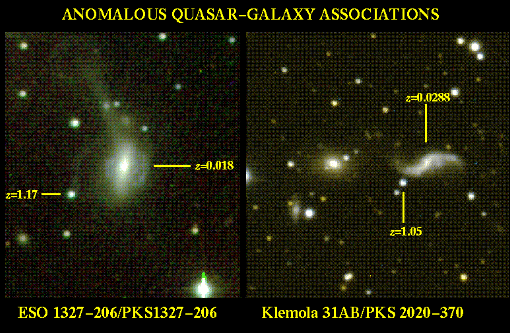
Non-velocity redshifts in galaxies. There are certain peculiarities, claimed or accepted, that suggest either strange behavior of redshifts or that we don't know how to measure them as well as we think. These take the forms of an inescapable asymmetry in redshifts of binary galaxies, and claims that such redshift differences are quantized and completely disallow a dynamical interpretation.
Redshift asymmetries are found in almost all samples of paired galaxies with precise redshifts, especially where spirals are involved. The tendency is for the fainter galaxy to have a slightly larger redshift, with a peak in the distribution at 50-80 km/s. The form of the distribution suggests that this is independent of background contamination. Conventional explanations have focussed on problem in measuring redshifts of dusty rotating disks (for example, if dust is stronger on the inside or outside of arms, the nuclear velocity may be distorted) or, for small groups, on expansion and perspective effects in unbound groupings (Byrd and Valtonen 1985 APJ 289, 535; 1986 ApJ 303, 523). This problem is not directly related to AGN, but letting one camel's nose into the Hubble tent might weaken its defenses for other applications. Detailed study of how one measures redshifts from optical spectra in complicated velocity fields shows that some of this effect comes from the different weightings of continuum and emission-line radiation (Keel 1996 ApJS 106, 27).
Tifft has claimed that redshift differences in galaxy pairs are quantized, with intervals from 12-72 km/s depending on sample size (Tiffy 1982 ApJ 257, 442; 257, 442, for example). Such an effect must nullify velocity Doppler shifts since, under conventional dynamics, they would smear out any other fine structure in the velocity distribution into invisibility. These distributions have naturally been the subject of vigorous (that's the polite word) debate. There have been claims that such periodicity could not be found from samples of the sizes used (Newman et al 1989 ApJ 344, 111), and possibly most damaging, the finding that though different data sets show similar DV distributions, a single pair may move from one peak to another depending on the particular measurement (Sharp, Trieste proceedings 1985). This last would imply that the periodicities exist in the data but not in the sky, a depressing though for people who want to do precise redshift surveys. Most recently, Tifft has concentrated on 21 cm redshifts, identifying several previously ignored sources of low-level error. However, there is a limit to how precisely one can consider some moment of an H I profile as representing "the" galaxy redshift - just look at a 21 cm map of M101, for example. The issue then is not one of how precise and repeatable a measurement is, but how well the measurement relates to a particular physical quantity in a complex system. Starting from slit spectra, I compared seven plausible ways to extract "the" redshift of a spiral galaxy, and found considerable scatter which must be due purely to internal structure (1996 ApJS 106, 27, the same one showing some systematic differences among them which may relate to redshift asymmetries in pairs). Sample periodicity diagrams are taken here from fig 1 of Tifft 1982 (ApJ 257, 442, courtesy of the AAS):

Any of the above phenomena would require explanation through some sort of new physics, the sort that people get to meet the King of Sweden for working out. Some of the original impetus for noncosmological redshifts arose, oddly enough, from conventional physics - the "synchrotron catastrophe", in which quasar luminosities would be too high to sustain against their own synchrotron self-absorption. However, Seyfert galaxies know how to do this perfectly well at smaller and better-determined distances, so this seems to be our problem and not the universe's. Furthermore, people such as Hoyle who found a steady-state universe appealing on philosophical grounds needed some other avenue to make objects that appear at first glance to show cosmological evolution. What do we require of any mechanism that can mimic Doppler shifts? It must
Some tentative explanations for various pieces have appeared. We need not require a complete theoretical framework to establish an empirical effect, but little is to be gained by jumping up and shouting "Oh no it's not" to every aspect of established theory without some new scheme. Hoyle and Narlikar have discussed ideas involving creation of mass and a finite sphere of graviton exchange, perhaps producing a homogeneous microwave background while they're at it. Some ideas involving backwards beaming from moving quasars have also been discussed to avoid blueshifts.
In his book, Arp sets out an evolutionary scheme that he finds acceptable from his interpretation. Objects are ejected from galactic nuclei, possible at very high velocities, with initially large density, high temperature, and large redshifts (quasars and BL Lac objects). As they age, stars appear starting with early-type ones and the redshift decreases. Finally, extended halos or spiral features appear, and the noncosmological redshift nearly vanishes. This gives sort of a fireworks-display view of galactic history. Most QSOs then are not very large or bright - more like the brightest supergiants than galaxy-hiding monstrosities.
So what are the arguments directly favoring conventional cosmological distances for quasars? We may examine associated and host galaxies, gravitational lenses, and absorption-line systems.
Galaxies are known to be associated with low-redshift QSOs both around the QSO itself and nearby (see the lecture on AGN hosts). It seems too much to ask that whole groups of galaxies can share the same disease and exactly mimic distance, or that there be two populations of QSOs so contrived as to have no observable distances but be of vastly different luminosity. Oddly enough, the resolved fuzz around high-redshift QSOs recently reported by Lehnert et al (1992 ApJ 393, 68) doesn't strengthen this argument - the (1+z)4 dimming in surface brightness makes normal galaxies unobservable at large redshifts, so these must be something that is peculiar by any standard. We are slowly learning that a QSO host galaxy need not look exactly like a quiescent counterpart (as in 3C 48). The broad relation between host galaxy magnitide and redshift may be construed as suggesting that the galaxies have distances related to redshift, and many are certainly galaxies containing stars as shown by direct spectroscopy.
Gravitational lensing will work only if the lens and QSO are at approximately their Hubble-law distances; this argument has been set out explicitly by Dar 1991 (ApJLett 382, L1). At the least, the QSO must be beyond the lens galaxy, which already has redshifts of order 0.5. Again, one must invoke quite a coincidence otherwise. Huchra has admitted orally that his first thought on discovering the Einstein cross was the chilling thought that Arp might have been right all these years.
Absorption-line systems again require that the QSO be beyond all the absorbing material unless all the intervening material has noncosmological redshifts as well. In this case, a strong coincidence is needed to make the redshift distributions of various kinds of absorber make any sense at all in a conventional model. Shaver has done an interesting test of QSO pairs at different distances; when absorption is seen at one QSO redshift, it's always the lower-redshift one against the high-z member. Much the same thing is found with associations of QSOs and low-redshift galaxies, although the absorbing gas seems to be patchy enough that some of the absorption lines are quite weak and one has to work hard to get a significant detection.
Occam's Razor has driven many people to conceive alternate schemes for AGN energy production, though most end up no less extreme than a massive black hole. Attention has recently focussed on the aftermath of a violent starburst, when some stars become extreme WR objects with effective temperatures near 105 K (sound familiar?). Terlevich and Melnick (1985 MNRAS 213, 841) have presented a picture where these so-called "Warmers" mimic a power-law spectrum and therefore match the ionization level seen in AGN. They suggest a sequence starburst - Sy 1 - Sy 2 as the supernovae drive broad line emission and die away. Filippenko has in fact found one supernova that looked for a time much like a Sy 1 nucleus, with narrow forbidden lines and broad Balmer and Fe II emission. This picture has trouble with jets and rapid variability, but is a useful reminder of why theories were driven to massive objects in the first place.
In a similar vein, Condon has recently argued that some quasars are intense starbursts confined within small regions. I am not sure that a starburst with 1012 solar luminosities in a region only 100 pc across is less exotic than a massive black hole. Besides, how do a bunch of stars manage collimated jets? At least an accretion disk gives some sort of natural funnel.
Connecting these pictures, Weedman (1983 ApJ 266, 479) notes that the neutron stars left over after a spatially confined starburst may undergo rapid collapse and give a small configuration mimicking in some respects that of a single object. Variability and collective effects pose challenges here.
The evidence in favor of the standard picture is hardly compelling (it would be marvellous to actually see an accretion disk on a larger scale than cataclysmic binary stars). It survives mostly because nothing better has shown up; the volume restrictions from variability, even when eased by Doppler factors, are formidable for anything except a relativistically compact object. Limits to the size of the object at the Galactic Center also rule out some of the exotic ideas other than a black hole, such as degenerate neutrino balls or quark configurations.
Last changes: 03/2003 © 2000-3